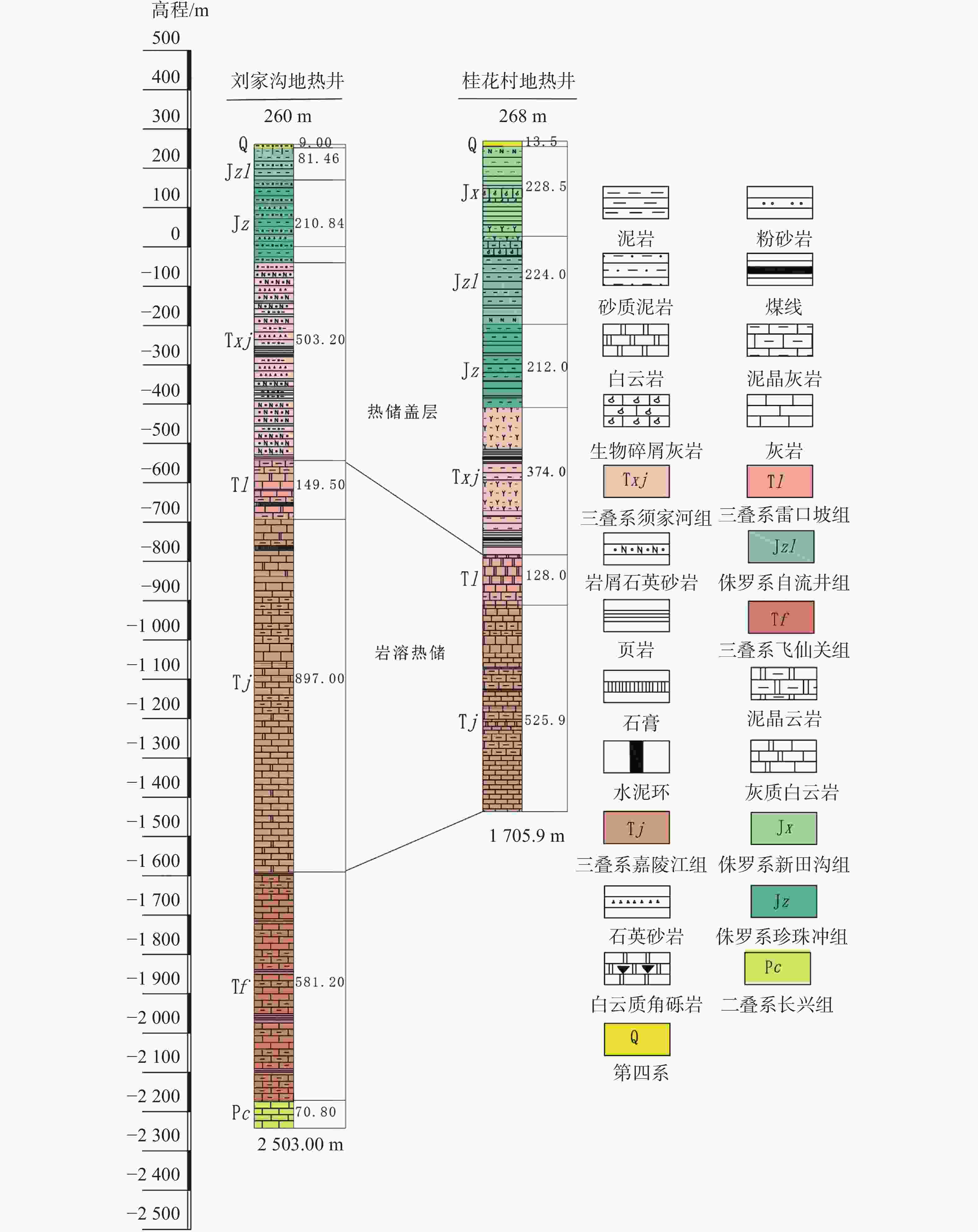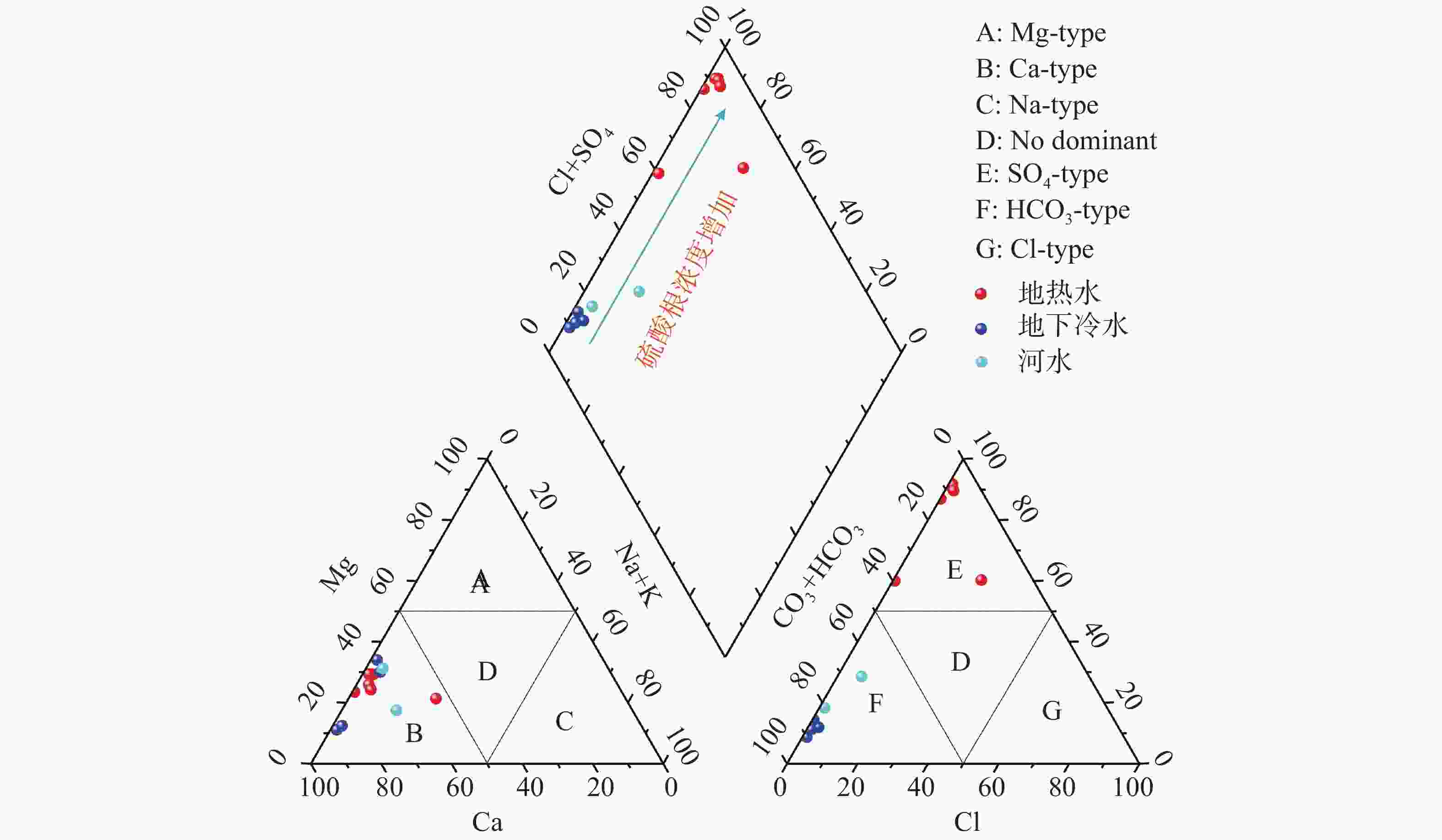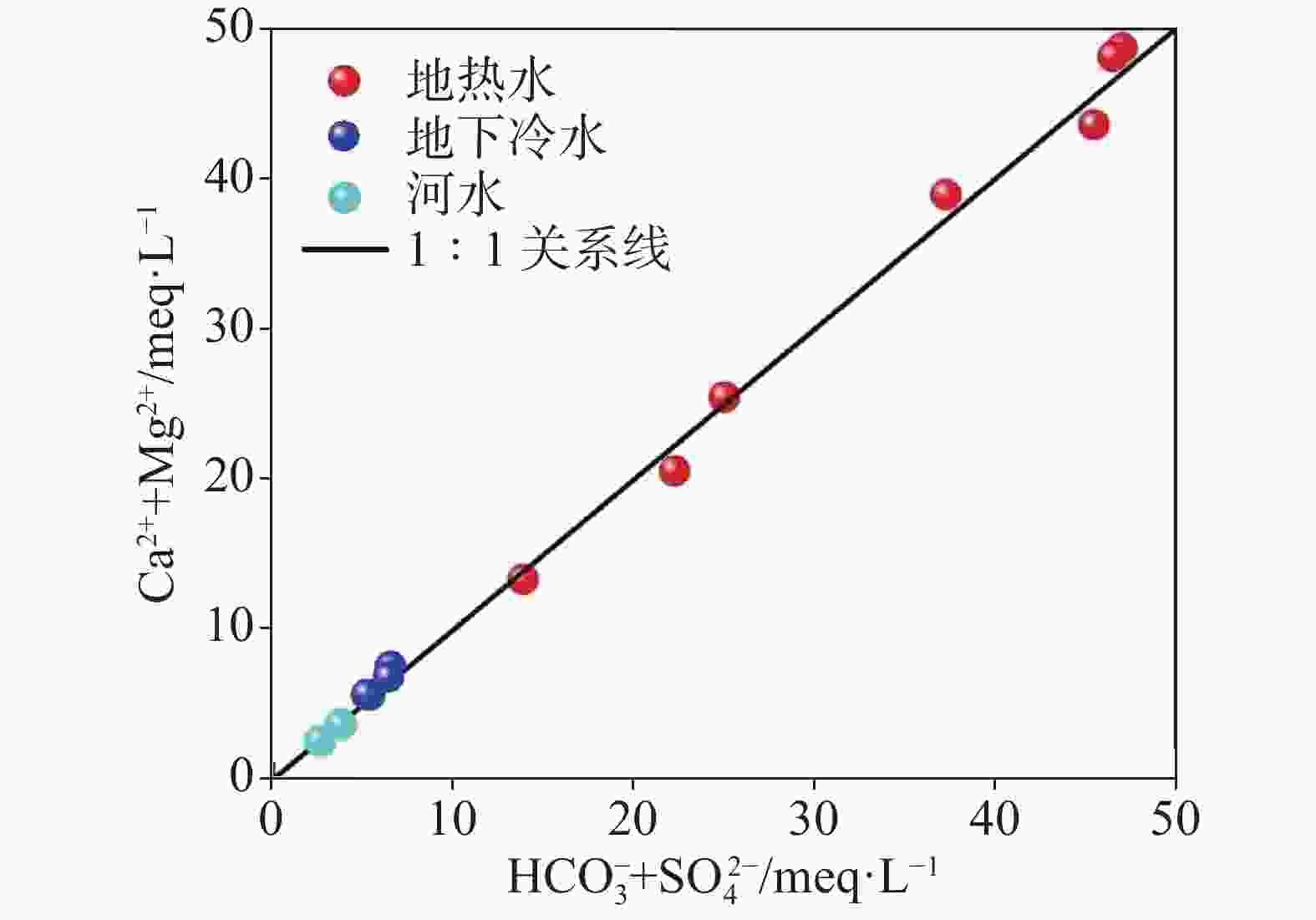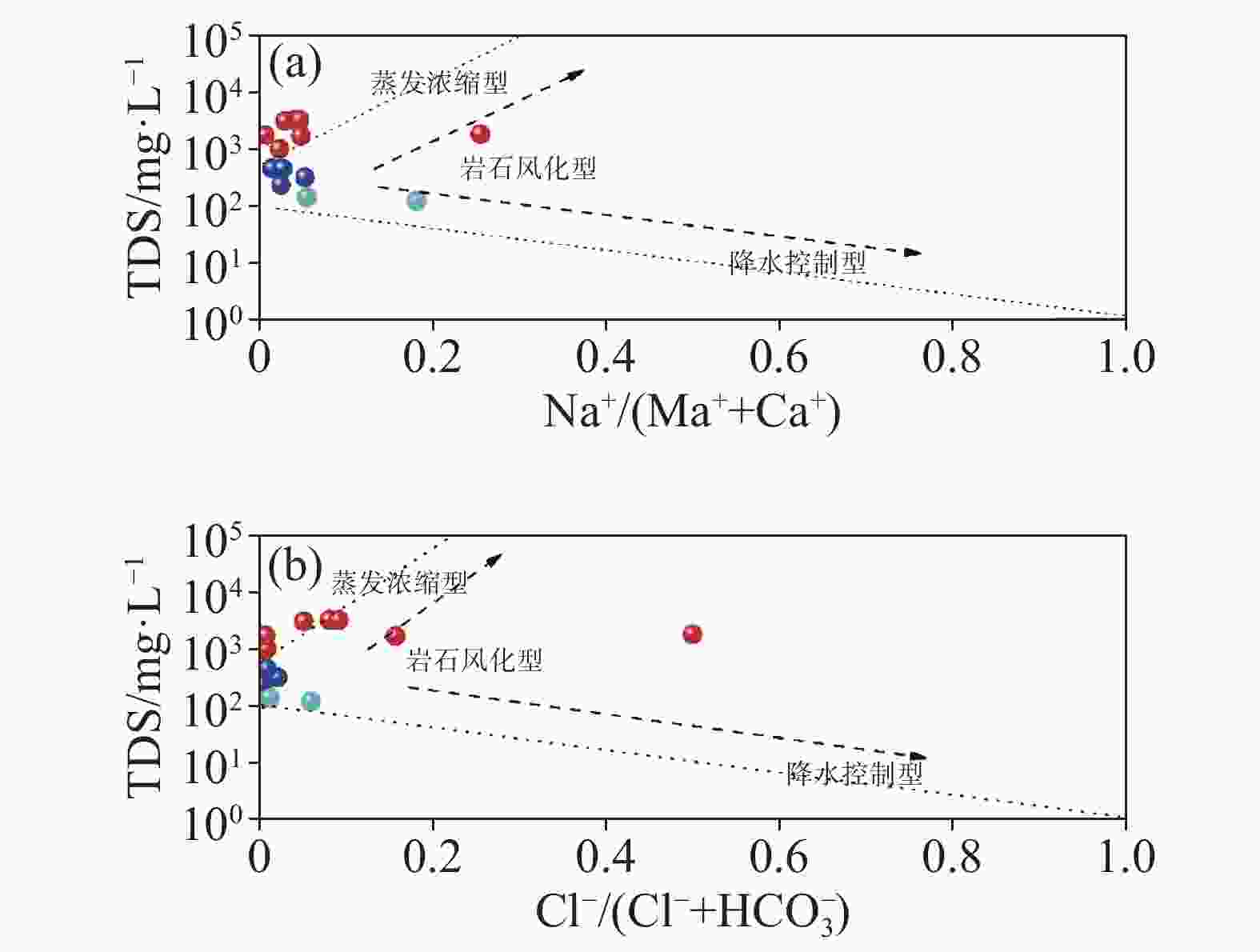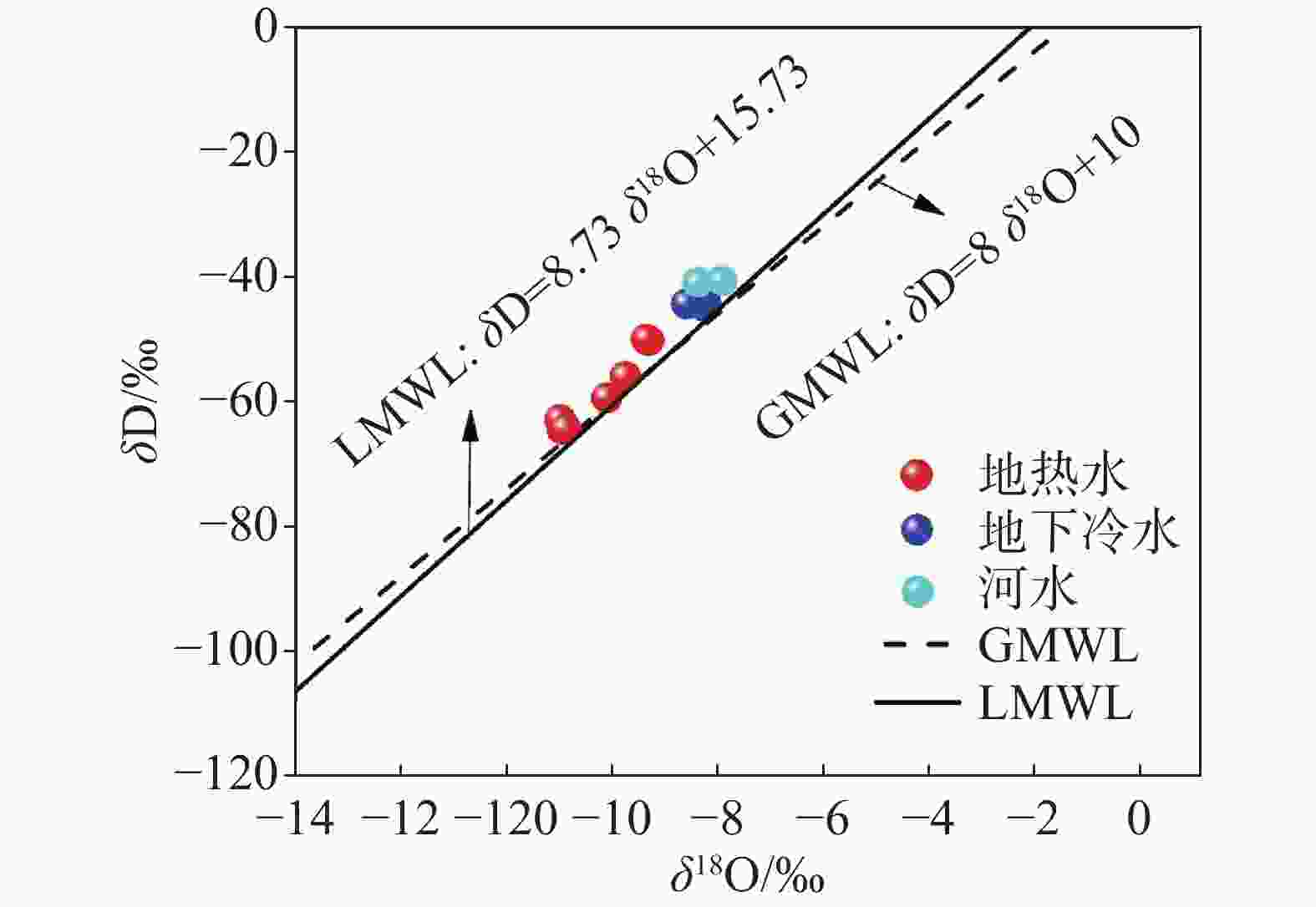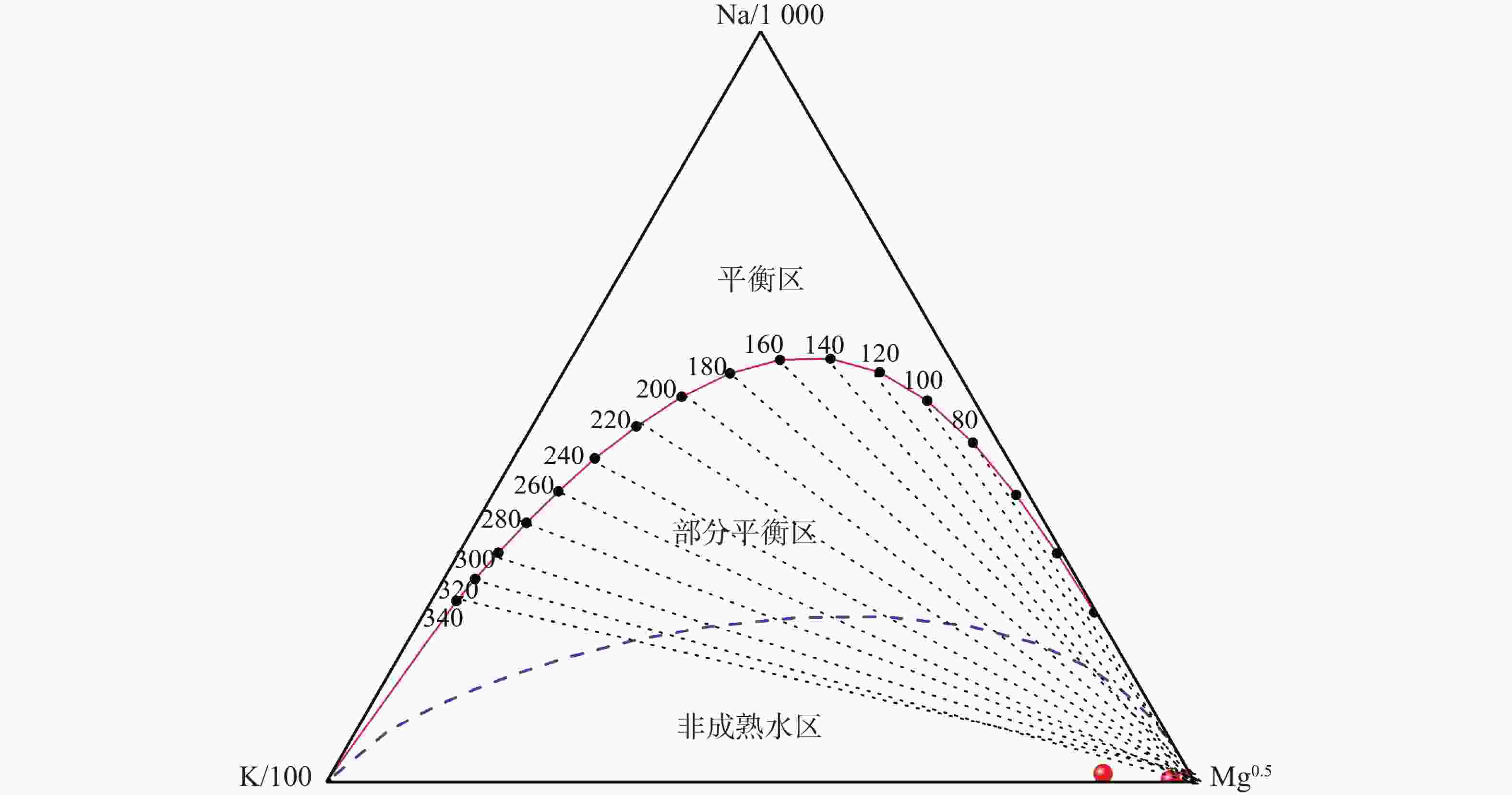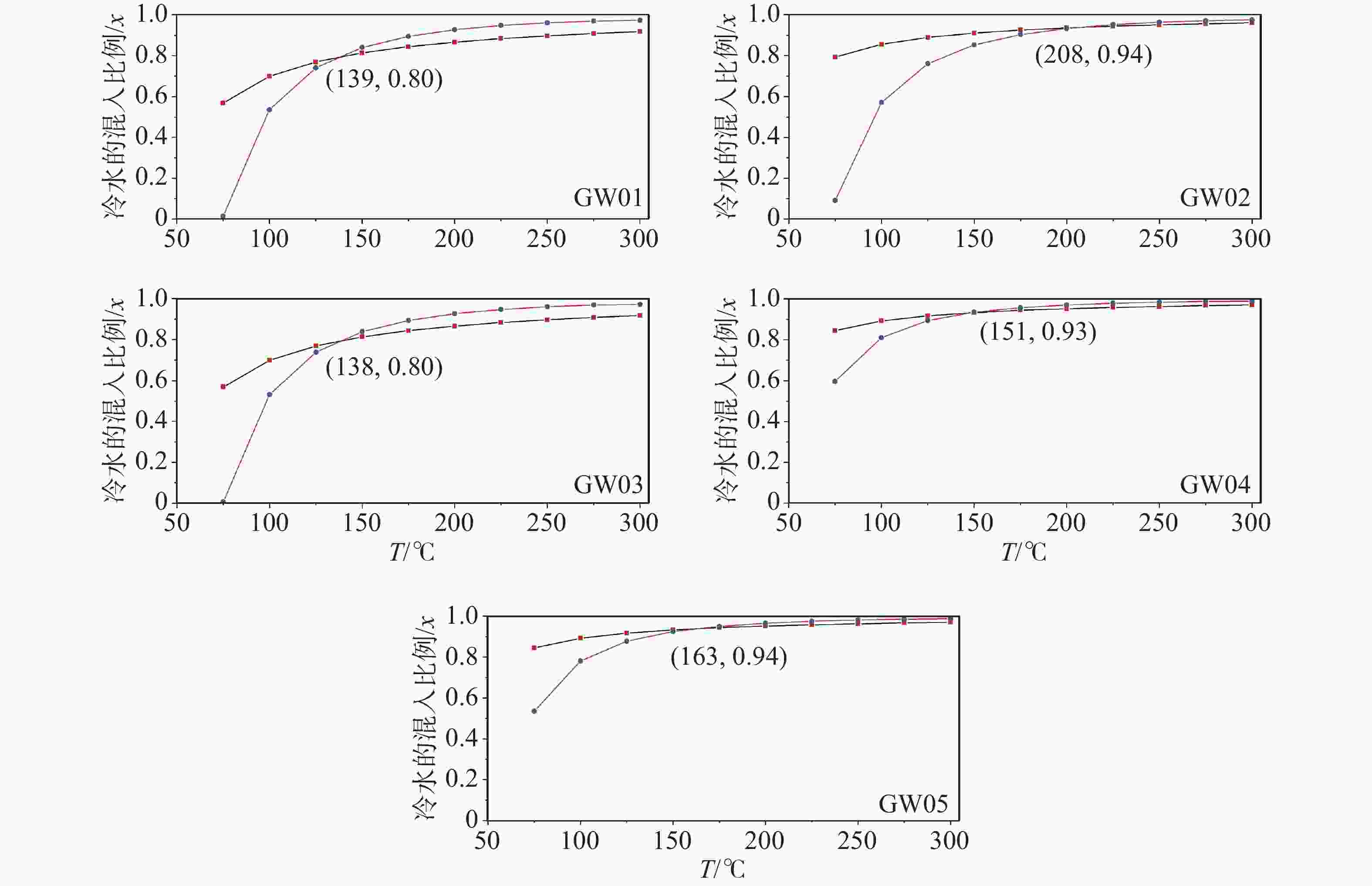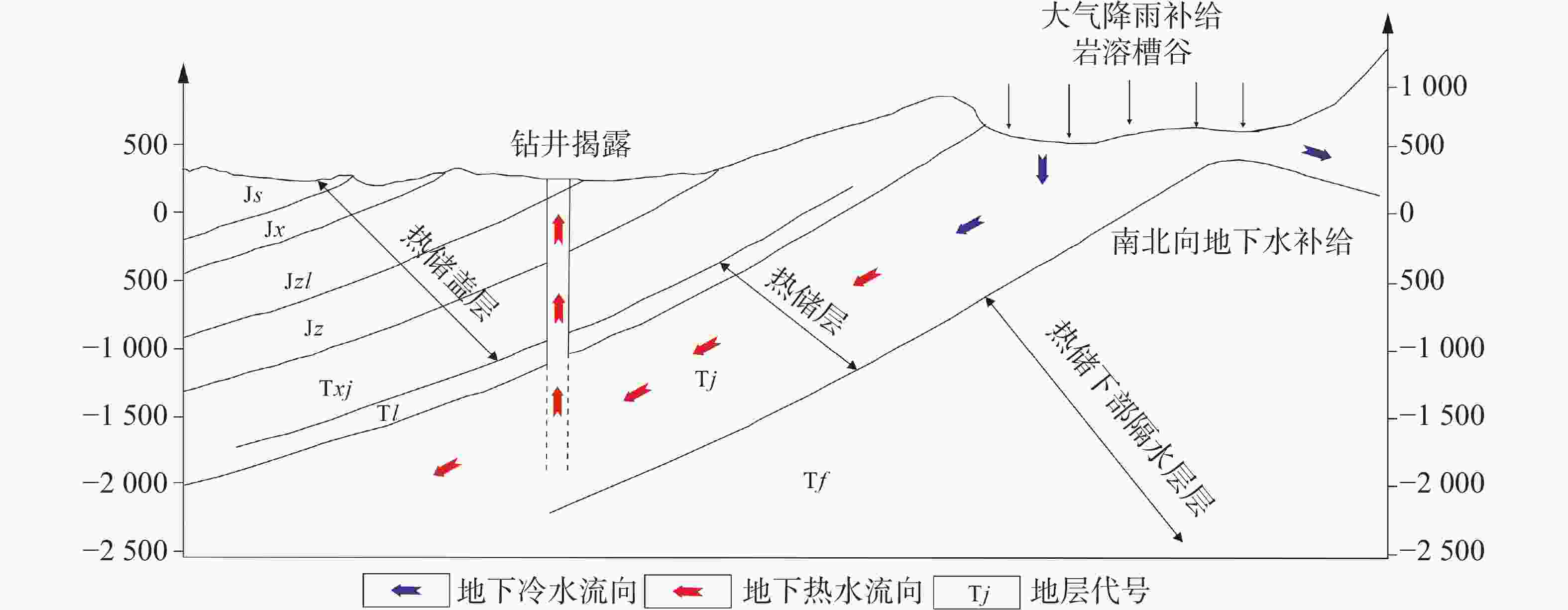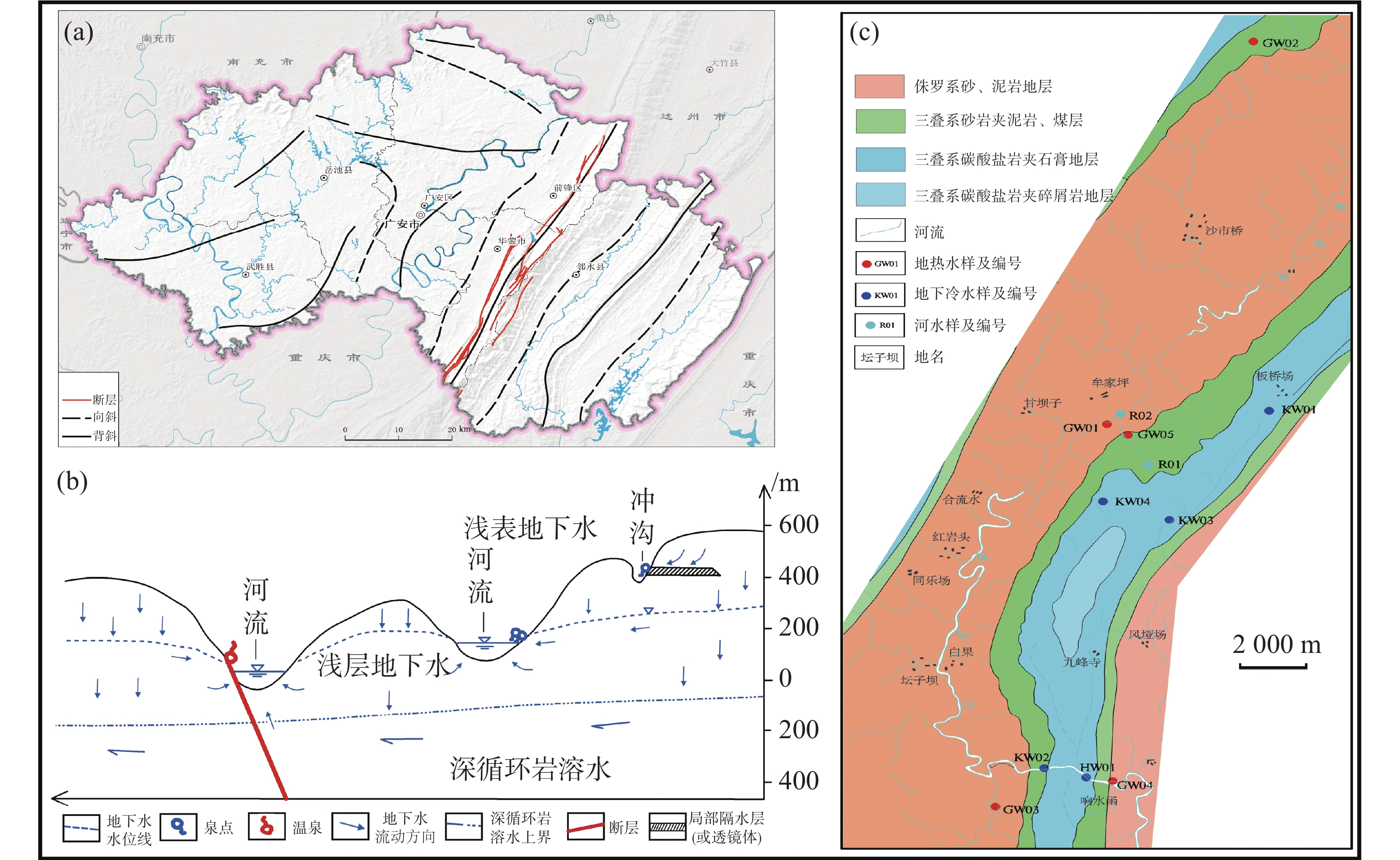Structural characteristics of Triassic carbonate geothermal reservoir and genesis of thermal water in the Tongluo mountain anticline of Guang’an City, China
-
摘要: 为探讨广安市铜锣山背斜三叠纪岩溶热储特征、地热水水化学与同位素组成、热储温度及地热水循环机理,采用地热钻探、水化学与同位素取样测试、热水溶质组分图解分析等手段和方法,开展了地热水成因的研究工作。结果表明:研究区三叠纪碳酸盐岩热储结构相对完整,热储盖层、热储层和热储下部隔水层形成独立的地热水文地质单元。岩溶地热水水化学类型主要为SO4-Ca·Mg和SO4-Ca型,富含F、Sr、Li、B和SiO2物质,其水源补给为大气降水,补给区位于铜锣山以北的大巴山一带,深部地热水补给高程大于1 100 m,补给区年均温度为9 ℃。热储温度为56~76 ℃,热水循环深度为2 013~3 030 m。地热水在循环过程中,主要发生碳酸盐岩和蒸发岩溶解、冷热水混合过程,且冷水混入比例大于80%。结合区域地热地质条件,构建了研究区地热水成因概念模型。Abstract:
There are abundant geothermal resources at low-medium temperature in the fold mountain areas of eastern Sichuan, and the main geothermal reservoirs are Leikoupo and Jialingjiang formations. Generally, karst geothermal reservoirs have the advantages of large water volume, easy reinjection of tail water after exploitation, and less damage to geothermal reservoirs. Recently, a great breakthrough in geothermal exploration of the Tongluo mountain anticline in fold mountain areas of eastern Sichuan has been achieved. Two deep geothermal wells with a depth of more than 1,700 m have been consecutively drilled to obtain karst geothermal resources with high development and utilization value. However, although good results have been obtained in terms of geothermal exploration, there are relatively few studies on the characteristics of geothermal reservoirs and the mechanism of geothermal water circulation. In the study on structure characteristics of Triassic karst geothermal reservoir, geothermal water chemistry and stable isotope composition, geothermal reservoir temperature, and mechanism of geothermal water circulation, methods including geothermal drilling, hydro-geochemistry, diagram analysis of thermal water components, and geo-thermometer assessment are used to analyze the occurrence condition of karst geothermal water and genetic model in this study area. Results show that the geothermal reservoir structure in the study area is relatively intact, and the cap layer of thermal reservoir, the thermal reservoir, and the lower water barrier layer are formed as independent geothermal hydrogeological units. Karst geothermal water is mainly SO4-Ca·Mg and SO4-Ca types and rich in contents of F, Sr, Li, B, and SiO2. The oxygen and hydrogen isotope analysis indicates that karst geothermal water is of meteoric origin, and the recharge area is located in the Daba mountainous area to the north of Tongluo mountain. The elevation of deep geothermal water recharge is more than 1,100 m; the average annual temperature of the recharge area is 9℃; the horizontal distance reaches 220 km. According to the SiO2 geo-thermometer, the karst geothermal reservoir temperature is 56-76℃; the circulation depth of geothermal water is 2,013-3,030 m, and the karst geothermal water is immature. Moreover, the dissolution of carbonate and evaporite and the mixing of cold groundwater are major hydro-geochemical processes in the geothermal water circulation path, and the mixing ratio of cold groundwater is higher than 0.8. Based on the results of geothermal geology, geothermal drilling, hydro-geochemistry, and environment isotopes, the genesis mechanism of geothermal water in this area is summarized as follows, groundwater receives water recharge from rainwater through karst depressions, sink, and pit of the Leikoupo and Jialingjiang formations in the anticline core region, heated by geothermal gradient and hot rock during the deep circulation of the anticline wing. During water circulation, major hydro-geochemical processes are water-rock interaction and thermal-cold water mixing. After then, karst geothermal water occurs along the anticline axis and wing region in forms of hot springs and geothermal wells. This study not only enriches the theory of the karst geothermal reservoirs system in the fold mountainous areas of eastern Sichuan but also provides a scientific basis for the exploration and exploitation of deep karst geothermal resources in this area. -
表 1 铜锣山背斜水样的物理—化学和同位素组分分析结果
Table 1. Physical-chemical and isotopic compositions of water samples in the Tongluo mountain anticline
编号 类型 水温 pH TDS HCO3− Cl− SO42− NO3− K+ Na+ Ca2+ Mg2+ F− Sr SiO2 Li B δD δ18O 补给
高程补给区
温度GW01 地热井 42 7.20 3242 208.00 18.30 2091.00 2.68 12.80 28.60 678.00 177.00 3.00 12.80 26.32 0.27 0.72 −64.53 −9.58 1251 9 GW02 地热井 29 7.16 3064 223.00 12.00 2004.00 — 9.65 18.20 609.00 157.00 2.95 13.40 24.85 0.02 0.13 −62.94 −9.61 1198 10 GW03 地热井 42 7.06 3230 208.00 20.90 2067.00 — 12.80 33.80 702.00 156.00 2.40 12.20 26.47 0.24 0.63 −64.38 −9.52 1246 9 GW04 地热井 26 7.24 1002 335.00 2.80 401.00 — 2.28 4.32 186.00 48.20 0.96 4.70 15.23 0.03 0.02 −50.32 −8.14 777 14 HW01a 温泉 30 7.33 1800 265.00 264.00 858.00 — 94.60 100.00 293.00 70.64 — 12.05 — — 0.86 −50.1 −8.18 770 14 HW02b 温泉 45 7.12 1680 183.00 34.00 1643.00 0.56 30.12 28.75 578.00 120.32 12.46 12.11 — — — −59.5 −8.84 1083 11 GW05 浅孔 26 7.33 1733 198.00 1.38 1044.00 — 3.59 2.53 388.00 72.70 1.84 8.44 16.39 0.06 0.19 −56.05 −8.53 968 12 KW01 岩溶泉 18 7.76 317 349.50 7.49 38.30 37.63 4.69 5.67 102.81 28.72 0.26 0.12 9.69 0.00 0.04 −44.76 −7.24 592 16 KW02 岩溶泉 18 6.74 232 333.40 1.08 44.40 1.13 1.03 2.24 89.10 28.60 0.17 0.37 11.04 — 0.02 −44.15 −7.20 572 16 KW03 暗河 16 7.13 455 298.00 2.50 22.50 12.34 1.64 1.47 100.00 7.68 0.13 0.44 7.54 0.00 0.00 −43.29 −7.33 543 16 KW04 暗河 17 7.29 450 281.00 2.50 28.20 11.59 1.61 2.70 98.70 8.77 0.10 1.80 7.85 0.00 0.01 −44.38 −7.52 579 16 R01 河水 18 6.24 140 186.10 2.16 33.50 1.37 2.47 2.84 49.10 14.50 0.11 0.14 10.01 — 0.02 −41.09 −7.33 — — R02 河水 18 6.74 121 109.80 6.92 38.30 7.94 3.31 8.94 40.50 6.42 0.07 0.43 12.41 — 0.03 −40.74 −6.93 — — 注:水温和补给区温度单位为℃;pH无量纲;δD和δ18O单位为‰;补给高程单位为m;化学组分单位为mg·L−1;“—”为未检出或未分析;a引自[25],b引自[26]等文献数据。 表 2 铜锣山背斜地热水热储温标计算结果
Table 2. Calculated results of geothermal reservoirs of the Tongluo mountain anticline
编号 t T1 T2 T3 T4 GW01 42 74 78 75 76 GW02 29 72 76 73 74 GW03 42 74 79 75 76 GW04 26 54 60 53 56 GW05 26 56 62 56 58 注:t为地热井或泉口水温;T1=1309/(5.19−lgSiO2)-273.15,为无蒸汽损失的石英温度计算式;T2=1522/(5.75-lgSiO2)−273.15,为最大蒸汽损失的石英温度计算式;T3=−44.119+0.24469S−1.7414×10−4×S2+79.305lgS,为改进的玉髓温标计算式;T4为T1、T2和T3的平均值;上述温度单位为℃。 表 3 深部热水温度、焓值和SiO2含量[34]
Table 3. Values of temperature, enthalpy and SiO2 in deep thermal water
温度/
℃焓值/
J·g−1SiO2/
mg·L−1温度/
℃焓值/
J·g−1SiO2/
mg·L−1温度/
℃焓值/
J·g−1SiO2/
mg·L−150 50.0 13.5 150 151.0 125.0 250 259.2 486.0 75 75.0 26.6 175 177.0 185.0 275 289.0 614.0 100 100.1 48.0 200 203.6 265.0 300 321.0 692.0 125 125.1 80.0 225 230.9 365.0 -
[1] 王贵玲, 张薇, 梁继运, 蔺文静, 刘志明, 王婉丽. 中国地热资源潜力评价[J]. 地球学报, 2017, 38(4):449-459. doi: 10.3975/cagsb.2017.04.02WANG Guiling, ZHANG Wei, LIANG Wiyun, LIN Wenjing, LIU Zhiming, WANG Wanli. Evaluation of geothermal resources potential in China[J]. Acta Geoscientica Sinica, 2017, 38(4):449-459. doi: 10.3975/cagsb.2017.04.02 [2] 庞忠和, 黄少鹏, 胡圣标, 赵平, 何丽娟. 中国地热研究的进展与展望(1995-2014)[J]. 地质科学, 2014, 49(3):719-727. doi: 10.3969/j.issn.0563-5020.2014.03.001PANG Zhonghe, HUANG Shaopeng, HU Shengbiao, ZHAO Ping, HE Lijuan. Geothermal studies in China: Progress and prospects (1995-2014)[J]. Chinese Journal of Geology, 2014, 49(3):719-727. doi: 10.3969/j.issn.0563-5020.2014.03.001 [3] Amatyakul P, Rung-Arunwan T, Siripunvaraporn W. A pilot magnetotelluric survey for geothermal exploration in Mae Chan region, northern Thailand[J]. Geothermics, 2015, 55:31-38. doi: 10.1016/j.geothermics.2015.01.009 [4] Baba A, Şaroğlu F, Akkuş I, Özel N, Yeşilnacar Mİ, Nalbantçılar MT, et al. Geological and hydrogeochemical properties of geothermal systems in the southeastern region of Turkey[J]. Geothermics, 2019, 78:255-271. doi: 10.1016/j.geothermics.2018.12.010 [5] Caudron C, Bernard A, Murphy S, Inguaggiato S, Gunawan H. Volcano-hydrothermal system and activity of Sirung volcano (Pantar Island, Indonesia)[J]. Journal of Volcanology and Geothermal Research, 2018, 357:186-199. doi: 10.1016/j.jvolgeores.2018.04.011 [6] DeRoin N, McNutt SR, Thompson G. Duration–amplitude relationships of volcanic tremor and earthquake swarms preceding and during the 2009 eruption of Redoubt Volcano, Alaska[J]. Journal of Volcanology and Geothermal Research, 2015, 292:56-69. doi: 10.1016/j.jvolgeores.2015.01.003 [7] Guo Q, Wang Y. Geochemistry of hot springs in the Tengchong hydrothermal areas, Southwestern China[J]. Journal of Volcanology and Geothermal Research, 2012, 215:61-73. [8] Rezaei A, Rezaeian M, Porkhial S. The hydrogeochemistry and geothermometry of the thermal waters in the Mouil Graben, Sabalan volcano, NW Iran[J]. Geothermics, 2019, 78:9-27. doi: 10.1016/j.geothermics.2018.11.006 [9] Zhao R, Shan X, Wu C, Yi J, Hao G, Wang P. Formation and evolution of the Changbaishan volcanic geothermal system in a convergent plate boundary back-arc region constrained by boron isotope and gas data[J]. Journal of Hydrology, 2019, 569:188-202. doi: 10.1016/j.jhydrol.2018.11.040 [10] Guo Q. Hydrogeochemistry of high-temperature geothermal systems in China: A review[J]. Applied Geochemistry, 2012, 27(10):1887-1898. doi: 10.1016/j.apgeochem.2012.07.006 [11] Li J, Sagoe G, Yang G, Liu D, Li Y. The application of geochemistry to bicarbonate thermal springs with high reservoir temperature: A case study of the Batang geothermal field, western Sichuan Province, China[J]. Journal of Volcanology and Geothermal Research, 2019, 371:20-31. doi: 10.1016/j.jvolgeores.2018.12.005 [12] Liu M, Guo Q, Zhang C, Zhu M, Li J. Sulfur Isotope Geochemistry Indicating the Source of Dissolved Sulfate in Gonghe Geothermal Waters, Northwestern China[J]. Procedia Earth and Planetary Science, 2017, 17:157-160. doi: 10.1016/j.proeps.2016.12.039 [13] Tian J, Pang Z, Guo Q, Wang Y, Li J, Huang T, et al. Geochemistry of geothermal fluids with implications on the sources of water and heat recharge to the Rekeng high-temperature geothermal system in the Eastern Himalayan Syntax[J]. Geothermics, 2018, 74:92-105. doi: 10.1016/j.geothermics.2018.02.006 [14] Yuan J, Guo Q, Wang Y. Geochemical behaviors of boron and its isotopes in aqueous environment of the Yangbajing and Yangyi geothermal fields, Tibet, China[J]. Journal of Geochemical Exploration, 2014, 140:11-22. doi: 10.1016/j.gexplo.2014.01.006 [15] 庞忠和, 庞菊梅, 孔彦龙, 郭世炎, 王树芳, 黄永辉, 罗霁, 胡圣标. 大型岩溶热储识别方法与规模化可持续开采技术[J]. 科技促进发展, 2020, 16(3-4):299-306.PANG Zhonghe, PANG Jumei, KONG Yanlong, GUO Shiyan, WANG Shufang, HUANG yonghui, LUO Qi, HU Shengbiao. Large-scale karst thermal storage identification method and large-scale sustainable mining technology[J]. Science and Technology for Development, 2020, 16(3-4):299-306. [16] 康凤新, 隋海波, 郑婷婷. 山前岩溶热储聚热与富水机理: 以济南北岩溶热储为例[J]. 地质学报, 2020, 94(5):1606-1624. doi: 10.3969/j.issn.0001-5717.2020.05.018KANG Fengxin, SUI Haibo, ZHENG Tingting. Heat accumulation and water enrichment mechanism of piedmont karstic geothermal reservoirs: a case study of northern Jinan[J]. Acta Geologica Sinica, 2020, 94(5):1606-1624. doi: 10.3969/j.issn.0001-5717.2020.05.018 [17] Yang P, Luo D, Hong A, Ham B, et al. Hydrogeochemistry and geothermometry of the carbonate-evaporite aquifers controlled by deep-seated faults using major ions and environmental isotopes[J]. Journal of Hydrology, 2019, 579:124116. doi: 10.1016/j.jhydrol.2019.124116 [18] 李明辉, 袁建飞, 黄从俊, 刘慧中, 郭镜. 四川广安铜锣山背斜热储性质及地热成因模式[J]. 水文地质工程地质, 2020, 47(6):36-46. doi: 10.16030/j.cnki.issn.1000-3665.202008038LI Minghui, YUAN Jianfei, HUANG Congjun, LIU Huizhong, GUO Jing. A study of the characteristics of geothermal reservoir and genesis of thermal groundwater in the Tongluoshan anticline near Guang’ an in east Sichuan[J]. Hydrogeology and Engineering Geology, 2020, 47(6):36-46. doi: 10.16030/j.cnki.issn.1000-3665.202008038 [19] 杨华云, 徐静. 重庆都市圈地热资源评价及开发利用方向[J]. 中国水运(学术版), 2006, (8): 217-218.YANG Huayun, XU Jing. Evaluation and development of deep geothermal water geothermal resources in Chongqing Metropolitan area ]J]. China Water Transport (Academic Version), 2006, (8): 217-218. [20] Xiao Q, Jiang Y, Shen L, Yuan D. Origin of calcium sulfate-type water in the Triassic carbonate thermal water system in Chongqing, China: A chemical and isotopic reconnaissance[J]. Applied Geochemistry, 2018, 89:49-58. doi: 10.1016/j.apgeochem.2017.11.011 [21] 吕玉香, 蒋晶, 杨平恒, 谢斌, 胡伟. 地热井井间干扰模拟研究: 以重庆观音峡背斜东翼为例[J]. 重庆大学学报, 2019, 42(2):94-104.LYU Yuxiang, JIANG Jing, YANG Pingheng, XIE Bin, HU Wei. Simulation of interwell interference in geothermal well- take the east wing of Guangyingxia anticline in Chongqing as an example[J]. Journal of Chongqing University, 2019, 42(2):94-104. [22] 李东升, 刘东升. 重庆地热水资源热储构造与径流补给[J]. 河海大学学报(自然科学版), 2011, 39(4):372-6.LI Dongsheng, LIU Dongsheng. Geothermal reservoir structure and runoff flow recharge of geothermal water resources in Chongqing Ctiy[J]. Journal of Hohai University (Natural Science), 2011, 39(4):372-6. [23] 袁建飞, 刘慧中, 李明辉, 黄丛俊, 杜德伟, 郭镜. 广安铜锣山地热勘探试验井地热地质成果及意义[J]. 科学技术与工程, 2022, 22(1): 83-92.YUAN Jianfei, LIU Huizhong, LI Minghui, HUANG Congjun, DU Dewai, GUO Jing. Geothermal geological achievements and significance of the geothermal exploration well in Tongluo Mountain, Guangan City [J]. Science Technology and Engineering, 2022, 22(1): 83-92. [24] 中国地质调查局成都地质调查中心. 广安市水文地质调查及地热资源勘查[R]. 成都: 中国地调查局成都地质调查中心, 2020: 15-30.Chengdu Center of China Geological Survey. Hydrogeological survey and geothermal resources exploration of Guangan City [R]. Chengdu: Chengdu Center of China Geological Survey, 2020: 15-30. [25] 漆继红, 许模, 杨华云, 王迪,赵红梅. 川东铜锣山背斜-南温泉背斜温泉水力联系分析[J]. 人民长江, 2011, 42(11):5-9. doi: 10.3969/j.issn.1001-4179.2011.11.002QI Jihong, XU Mo, YANG Huayun, WANG Di, ZHAO Hongmei. Analysis on hydraulic connection of hot springs of Tongluo Mountain anticline to South hot spring anticline in eastern Sichuan Province[J]. Yangtze River, 2011, 42(11):5-9. doi: 10.3969/j.issn.1001-4179.2011.11.002 [26] 肖琼, 沈立成, 袁道先, 杨雷, 陈展图, 汪智军. 利用δ18O和δ34S示踪重庆都市圈地下热水循环过程[J]. 重庆大学学报, 2011, 34(5):87-92. doi: 10.11835/j.issn.1000-582X.2011.05.016XIAO Qiong, SHEN Licheng, YUAN Daoxian, YANG Lei, CHEN Zhantu, WANG Zhijun. Using δ18O and δ34S isotopic techniques to trace the recycling process of hot springs in Chongqing metropolitan[J]. Journal of Chongqing University, 2011, 34(5):87-92. doi: 10.11835/j.issn.1000-582X.2011.05.016 [27] 余琴, 杨平恒, 王长江, 李国, 张宇, 张媚, 谢正兰. 重庆市统景温泉水化学特征及混合作用[J]. 中国岩溶, 2017, 36(1):59-66. doi: 10.11932/karst20170107YU Qin, YANG Pingheng, WANG Changjiang, LI Guo, ZHANG Yu, ZHANG Mei, XIE Zhenglan. Hydrochemical characteristics and mixing effect in Tongjing hot springs of Chongqing[J]. Carsologica Sinica, 2017, 36(1):59-66. doi: 10.11932/karst20170107 [28] 余浩文, 刘昭, 荣峰, 陈康, 男达瓦, 刘仕娟, 刘绍赟. 西藏错那地热田水化学特征与物源机制[J]. 地质科技通报, 2021, 40(3):34-44.YU Haowen, LIU Zhao, RONG Feng, CHEN Kang, NAN Dawa, LIU Shijuan, LIU Shaoyun. Characteristics and source mechanism of geothermal field in Cuona, Tibet[J]. Bulletin of Geological Science and Technology, 2021, 40(3):34-44. [29] 袁建飞, 邓国仕, 徐芬, 唐业旗, 李鹏岳. 川西南喜德热田地下水水文地球化学特征[J]. 现代地质, 2017, 31(1):200-208. doi: 10.3969/j.issn.1000-8527.2017.01.019YUAN Jianfei, DENG Guoshi, XU Fen, TANG Yeqi, LI Pengyue. Hydrogeochemical characteristics of groundwater in the Xide geothermal field, Southwest Sichuan, China[J]. Geoscience, 2017, 31(1):200-208. doi: 10.3969/j.issn.1000-8527.2017.01.019 [30] 张娟, 张海庆, 黄丹, 王心义. 基于水化学特征的深部岩溶地热水循环机制研究[J]. 河南理工大学学报(自然科学版), 2010, 29(6):741-745. doi: 10.16186/j.cnki.1673-9787.2010.06.001ZHANG Juan, ZHANG Haiqing, HUANG Dan, WANG Xinyi. Study on circulation mechanism of geothermal water in deep karst based on water chemical characteristics[J]. Journal of Henan Polytechinc University (Natural Science), 2010, 29(6):741-745. doi: 10.16186/j.cnki.1673-9787.2010.06.001 [31] Yang Pingheng, Cheng Qun, Xie Shiyou, Wang Jianli, Chang Longran, Yu Qin, Zhan Zhaojun, Chen Feng. Hydrogeochemistry and geothermometry of deep thermal water in the carbonate formation in the main urban area of Chongqing, China[J]. Journal of Hydrology, 2017, 549:50-61. doi: 10.1016/j.jhydrol.2017.03.054 [32] 罗云菊, 刘东燕, 许模. 重庆地下热水径流特征研究[J]. 地球与环境, 2006(1):49-54. doi: 10.14050/j.cnki.1672-9250.2006.01.009LUO Yunju, LIU Dongyan, XU Mo. Studyon the geothermal water runoff in Chongqing[J]. Earth and Environment, 2006(1):49-54. doi: 10.14050/j.cnki.1672-9250.2006.01.009 [33] 潘明, 郝彦珍, 吕勇, 李波. 云南昌宁橄榄河热泉水化学特征及复合成因机制研究[J]. 中国岩溶, 2021, 40(2):281-289.PAN Ming, HAO Yanzhen, LV Yong, LI Po. Hydrochemical characteristics and composite genesis of a geothermal spring in Ganlanhe, Changning, Yunnan Province[J]. Carsologica Sinica, 2021, 40(2):281-289. [34] 徐刚, 伍坤宇, 王鹏, 陈永东, 李兴彦, 胡林, 刘子畅, 李海. 藏北温泉盆地地热田水文地球化学特征研究[J]. 中国岩溶, 2020, 39(3): 299-310.XU Gang, WU Kunyu, WANG Peng, CHEN Yongdong, LI Xingyan, HU Lin, LIU Zichang, LI Hai. Hydrogeochemical characteristics of the geothermal field in Wenquan basin, northern Tibet ]J]. Carsologica Sinica, 2020, 39(3): 299-310. -




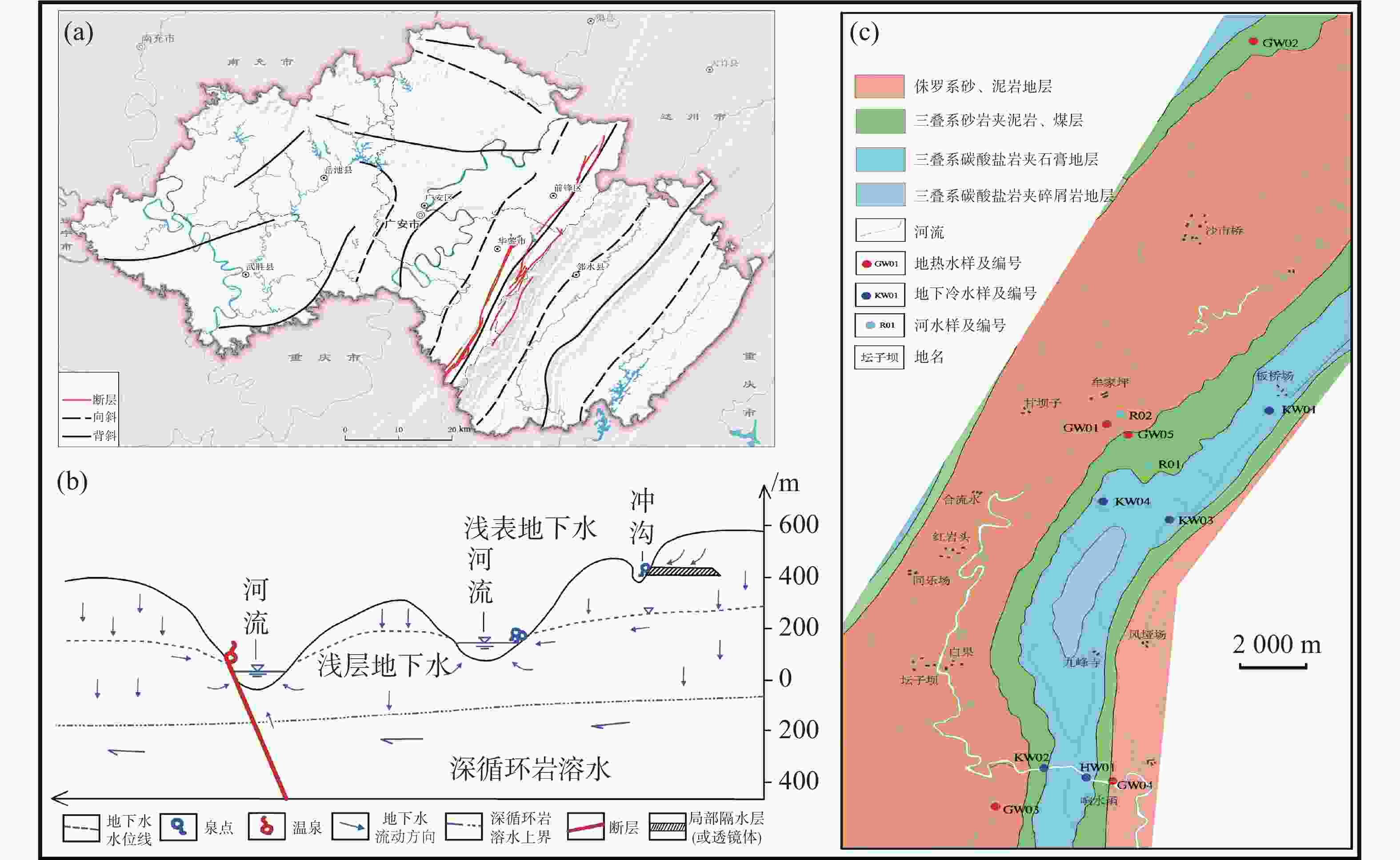
 下载:
下载:
